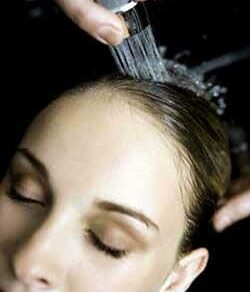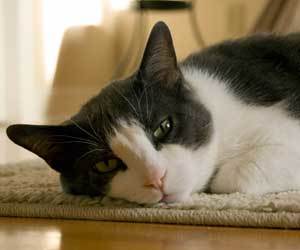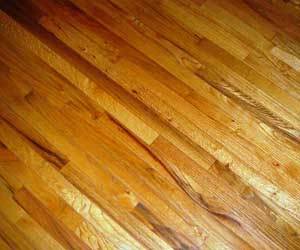Fleas are a common problem for almost any furry pet that is allowed outside. The reason they are such a problem is because they reproduce quickly (females can lay up to 50 new eggs per day), and despite popular belief, they don’t live on your pet full-time; they only jump on them every now and then for a meal, then head back to their home in your carpet or upholstery. Fleas have four life stages: egg, larvae (tiny black worm-like creatures), pupae (white cocoons that larvae make to live in while they grow into adult fleas), and adults. Unfortunately, commercial flea medicines can only kill eggs, larvae, and adults, so your flea battle will continue on until all of the pupae have hatched. Thankfully, commercial flea medicines are not necessary to eradicate the fleas from your home.
Removing Fleas from the Environment
You Will Need:
- A vacuum
- Salt
- Food grade diatomaceous earth
- Carpet flea powder
- A steam cleaner
- Peppermint castile soap
- Dawn dish liquid
- Dried rosemary
- Dried thyme
- Dried fennel
- A blanket
- A pillowcase
- Cedar shavings
- A lint roller
- A low-watt light bulb
- A gooseneck lamp
- A pan
- A lawn mower
- White tube socks
- Various live plants
Removing the Fleas:
- In order to eradicate the fleas from your home, you will need to vacuum everywhere your pet goes indoors, including in the car if they go out with you. Use the brush attachment to scrub any carpets or rugs while vacuuming to try to jostle loose the sticky pupae cocoons. Repeat this process every few days at the least. Larvae can hatch within 24 hours from when the egg was laid, so you need to be sure you get rid of them before they become pupae.
- Add a small scoop of diatomaceous earth to the vacuum canister so any flea offspring you pick up will be dehydrated (killed) in the vacuum.
- Sprinkle salt, food grade diatomaceous earth, or a carpet flea powder over your carpet with a colander, then walk over the powder to help grind it into the fibers. Leave the powder on the carpet for 1-3 days, then vacuum it up. Repeat the powder treatment every few days for 2-3 weeks or until the infestation is over.
- Remove as much clutter, piles of laundry, or stacks of paper as you can to take away as many hiding places for fleas as you can.
- Steam cleaning the carpet is an effective way to kill fleas and their offspring, including pupae.
- If you can’t replace your vacuum bag after each use while fighting fleas, remove it from the vacuum, put it in a black trash bag, tie the bag well, then set it out in the sun for a couple days.
- Mix a tablespoon of peppermint castile soap in a spray bottle with two quarts of water. Spray the mixture along the edges of each room and around the perimeter of the house to deter fleas. Don’t spray the carpet; the residue from the soap will attract dirt if you do.
- No carpets? Focus on the base of your drapes, along baseboards or window sills, and in the seams of the flooring or upholstery. These areas can be vacuumed, as well as sprayed with one of the mixtures from #7 or #10. Only apply sprays to water-safe fabrics.
- Sprinkle salt into any seams or cracks in your flooring. Leave the salt for three or more hours, then vacuum it up.
- Spray your floors with a mixture of ½ tablespoon Dawn Dish Liquid in 1 cup of water. Leave the mixture on the floor for 15-20 minutes, then use a damp towel to mop it up.
- Sprinkle some rosemary, fennel, or cedar shavings near your pet’s bedding to help deter fleas from the area.
- Laying a blanket over your pet’s bed provides an easy way to remove all of the flea offspring and help to ensure that no pupae are able to burrow into the fibers of your pet’s bed. Wash the blanket every few days with hot water and detergent.
- Make a flea-deterrent bed for your pet by filling a pillowcase with cedar shavings, then sewing it shut. (This is particularly helpful for an outdoor bed.)
- Run a lint roller over your pet’s bed each day to remove as much flea offspring from that day as you can.
- Create a flea trap by putting a low-watt bulb (60W or less) in a gooseneck-style lamp. Put a pan of soapy water on the floor and shine the light over the water. Leave this trap in place all day and night, being cautious of creating a fire hazard with a paper or fabric lampshade and ensuring that your pet can’t knock the lamp over into the water. Move the trap to a new room each day until you find no more fleas in the trap in each room. If your pet might drink the water, lay a piece of mesh over the top of the water that has holes small enough to keep your pet’s tongue out, but large enough for the shiny surface of the water to be visible.
- Another type of flea trap is to set a heating pad to low heat and lay it over a cushion on the floor. Put a flannel over the heating pad, then sprinkle diatomaceous earth or borax on top of the flannel.
- Cut your grass short and remove any lawn clutter that you can, such as grass clippings or dead leaves or sticks.
- Put on white tube socks and walk around your yard to determine which areas are hot spots for flea activity.
- Use food grade diatomaceous earth to make a natural flea spray for your yard by mixing 5 tablespoons of DE into a gallon of water. Stir the mixture well, then put it in a spray bottle. Spray any shaded cool areas and grassy areas of your yard, shaking the bottle as needed to redistribute the DE in the water. Keep in mind that this spray will kill most other bugs as well, so use caution not to spray the hang-out of any bugs you do like. Reapply this spray weekly for a month.
- Add flea-deterrent plants to your yard when planting, such as rosemary, sage, thyme or catmint. Lavender can also be added to yards that do not contain cats.
Removing Fleas from your Pet
You Will Need:
- Various essential oils
- Olive oil
- Ground fennel
- Ground rosemary
- Cornstarch
- Baking soda
- White vinegar
- Fresh rosemary
- Castile soap
- Dawn dish liquid
- A flea comb
- A lint roller
- Apple cider vinegar
- Brewer’s Yeast
- Rosemary
- Thyme
- Lemon lotion
Removing the Fleas:
- Make a flea deterrent for your dog’s coat by adding ¼ teaspoon of rosemary essential oil to ¼ cup of olive oil. Put a couple drops of the mixture on a cloth, then rub the oil over your pet’s fur. Essential oils should not be used on cats.
%27%20fill-opacity%3D%27.5%27%3E%3Cpath%20fill-opacity%3D%22.5%22%20d%3D%22M-18.2%2035.7l159.4%20195.7%20177-154.6z%22%2F%3E%3Cellipse%20fill%3D%22%23c6c6c6%22%20fill-opacity%3D%22.5%22%20rx%3D%221%22%20ry%3D%221%22%20transform%3D%22rotate(-124.5%20194.8%2061)%20scale(63.26047%20283.56569)%22%2F%3E%3Cellipse%20fill%3D%22%23e9e9e9%22%20fill-opacity%3D%22.5%22%20rx%3D%221%22%20ry%3D%221%22%20transform%3D%22rotate(-94%20113%20-101.6)%20scale(31.28578%20129.50458)%22%2F%3E%3Cpath%20fill%3D%22%23949494%22%20fill-opacity%3D%22.5%22%20d%3D%22M88.5%20315.8H-66.2V121.3H88.5z%22%2F%3E%3C%2Fg%3E%3C%2Fsvg%3E) Make a flea powder for your cat or dog’s coat by adding two teaspoons each of ground fennel and ground rosemary to a half cup of cornstarch. Stir the powder well, then sprinkle it over your pet like a dry shampoo and rub it into their coat. The powder can stay on your pet as long as needed, but the herbs will become less potent after a couple weeks. Use caution not to get the powder in their eyes or nose.
Make a flea powder for your cat or dog’s coat by adding two teaspoons each of ground fennel and ground rosemary to a half cup of cornstarch. Stir the powder well, then sprinkle it over your pet like a dry shampoo and rub it into their coat. The powder can stay on your pet as long as needed, but the herbs will become less potent after a couple weeks. Use caution not to get the powder in their eyes or nose.- A flea powder recipe alternative for dogs is to pour baking soda into a bowl, then sprinkle a few drops of a flea-deterring essential oil onto the powder, such as rosemary, cedar or peppermint. Rub the powder into your dog’s coat, let it sit for 10-15 minutes, then brush out the powder. Use caution not to get the powder in their eyes or nose. Do not use this powder on cats.
- To make a natural flea spray for your dog or cat, combine equal amounts of white vinegar and water. Spray the mixture lightly onto your pet’s coat and massage it into the fur.
- Another natural flea spray recipe is to pour boiling water over a cup of fresh rosemary. Let the rosemary steep in the water for about an hour, then spray the scented water over your pet’s coat and rub it in.
- To make a natural shampoo to remove fleas from your pet, add a tablespoon of castile soap and ¼ teaspoon of vegetable oil to 10 ounces of water. Stir the mixture well, then squeeze it onto your pet’s fur, lather and leave the lather on your pet for a few minutes if possible, then rinse well. As you wash your pet, the fleas that survive will go to the highest/driest point, usually on their head or nose. Run a flea comb over this area while your pet is still lathered or wet.
- Dawn dish liquid can be used as a shampoo to remove fleas from your pet.
- If you want to use a flea comb to remove some adult fleas, set a cup of soapy water next to you and comb your pet, focusing on their neck and ears, as well as the base of their tail. When a flea comes out of the fur on the comb, pick it up between two fingers and put it in the soapy water.
- If you see any white specs on your pet that resemble salt, those are likely flea eggs. Run a lint roller over their coat each day to remove as many flea eggs as you can.
- A teaspoon of apple cider vinegar in each quart of your dog or cat’s drinking water can help to keep fleas away from them.
- Give your pet a food or treat that contains brewer’s yeast, or sprinkle a teaspoon of it over your pet’s food to make them taste bad to fleas.
- Tie a chamomile tea bag or a sprig of rosemary or thyme onto your dog’s collar before a walk or put a couple drops of a flea-repelling essential oil on their collar, such as rosemary, cedar, or orange oil.
- There are a variety of commercial flea treatments for your pet, including topical ointments, sprays, powders, pills, dips, and shampoos. Follow the instructions on the label of your selected product. Shampooing your pet regularly is the safest option. Pills and dips are particularly strong and should be used with caution, especially for older or sick pets.
- After your pet is treated with a flea medicine or deterrent, the fleas that survive in the environment will look for a new food source, which usually means you. Protect yourself by rubbing some lemon or orange-scented lotion on your ankles, shins and the top of your feet. If your pet spends a lot of time in your bedroom, rub the lotion over your entire body each night before bed. Try to choose a lotion that contains lemon or orange ingredients rather than an artificially scented product. Desert Essence makes a lemon lotion using lemon peel oil, which can be found at most health food stores.
Additional Tips:
- Start protecting your home from fleas at the end of winter or very early spring each year.
- Never use a dog flea medicine on a cat, or a cat flea medicine on a dog; this can make your pet very sick.
- Use special caution when considering a flea medicine for a Persian cat. Consult a veterinarian for a safe recommendation.
- Use caution when choosing a flea medicine if you have children.
- Pets, especially cats, are sensitive to a variety of plants and essential oils. Always make sure a product, even a natural one, is safe for your pet before using it in your home.
- Avoid flea collars; they are much less effective than other flea medicine systems. If you do decide to use a flea collar, be sure to check the expiration date on it and never use it in addition to another flea medicine.
- Diatomaceous earth is available at most local hardware stores and supermarkets.
- There are many diatomaceous earth products on the market that are mixed with chemicals. Use caution to only buy the food-grade kind.
- Once a pet has fleas, keep an eye out for tapeworms, which they can get by ingesting one of the fleas while bathing themselves. Tapeworms can easily be diagnosed by finding any hard yellow balls on your pet’s bedding, which are tapeworm offspring that have dried up due to exposure to the air. Tapeworm medication is available over the counter.
Sources:
- Pet Clean-Up Made Easy by Don Aslett
- Better Basics for the Home by Annie Berthold-Bond
- Home Comforts: The Art and Science of Keeping House by Cheryl Mendelson
- Going Green Using Diatomaceous Earth How-To Tips by Tui Rose
- Amazing Kitchen Cures by Joey Green
- Green Housekeeping by Ellen Sandbeck
- Pet Clean-Up Made Easy by Don Aslett
- The Country Almanac of Housekeeping Techniques That Save You Money by Richard Freudenberger and Backhome Magazine
- Natural Alternatives for You and Your Home by Casey Kellar
- Household Hints for Dummies by Janet Sobesky
- Clean It Fast, Clean It Right by Jeff Bredenberg
- Extraordinary Uses for Ordinary Things by Reader’s Digest
- Practical Problem Solver by Earl Proulx
- Lemons and Lavender; The Eco-guide to Better Homekeeping by Billee Sharp

 Make a flea powder for your cat or dog’s coat by adding two teaspoons each of ground fennel and ground rosemary to a half cup of cornstarch. Stir the powder well, then sprinkle it over your pet like a dry shampoo and rub it into their coat. The powder can stay on your pet as long as needed, but the herbs will become less potent after a couple weeks. Use caution not to get the powder in their eyes or nose.
Make a flea powder for your cat or dog’s coat by adding two teaspoons each of ground fennel and ground rosemary to a half cup of cornstarch. Stir the powder well, then sprinkle it over your pet like a dry shampoo and rub it into their coat. The powder can stay on your pet as long as needed, but the herbs will become less potent after a couple weeks. Use caution not to get the powder in their eyes or nose.






Leave a reply